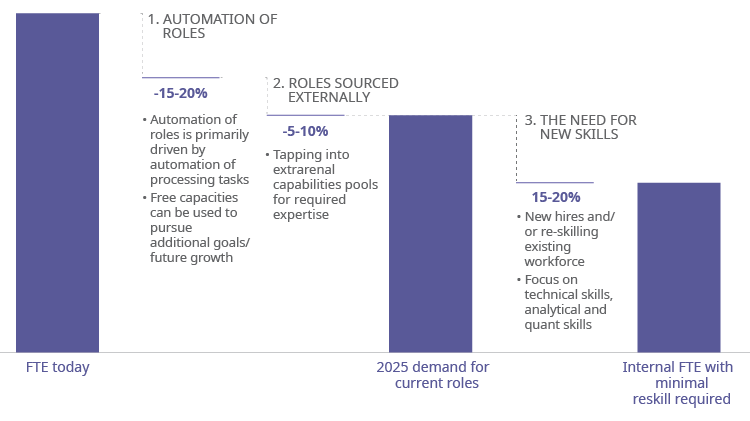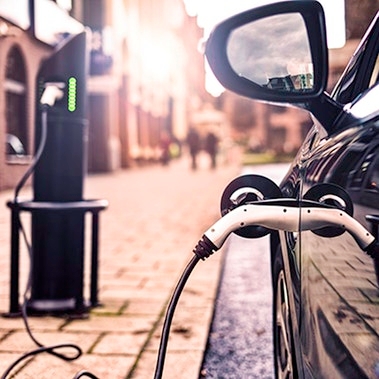These changes could lead to a head-on collision between traditional automotive companies – which have long prized caution and remain risk-averse to unproven technologies – and new players willing to take risks and move faster to exploit new value pools.
TRANSFORMING THREE CRITICAL AREAS
To handle the EV surge, incumbents must redesign how they develop new products; recalibrate their cultures; and reskill their workforces
Product strategies and partnerships
During the transition from internal combustion engines (ICE) to EVs automakers must decide how best to integrate advances in electric propulsion. Until the technology matures, costs come down, and volumes reach the scale needed to make EVs profitable, the transition from ICE to EV could follow multiple paths. Oliver Wyman forecasts battery powered vehicles to reach a quarter of the new vehicle global market by 2030 with over 60 percent of vehicles having some form of electrification by then, but there will be significant differences by region.
Players are already making major investments in critical new technologies, especially electric propulsion and autonomous vehicles. Sharing these costs makes sense, but choosing the right partner could be challenging: Companies require partners that share a similar culture and vision or else disagreements will impede progress and lead to higher development costs. Nonetheless, a well-executed strategic partnership can reduce risk and enable success by allowing new ventures with access to alternative funding sources to push the innovation envelope.
Technology-wise, industry players must choose among mild hybrid (such as 48-volt systems), full hybrid (HEV), plug-in hybrid (PHEV), or battery EV (BEV) propulsion systems, and whether to use unique EV platforms or shared ICE and BEV approaches. They must also decide which components to outsource and which to produce in-house – choices that will affect their manufacturing strategies. For example, while building an HEV or PHEV on an existing ICE platform requires few trade-offs, the jump to a full BEV on the same platform can be more difficult. One premium European player is building full-electric versions of existing vehicles by modifying the original ICE platforms, potentially enabling greater manufacturing flexibility but at the potential cost of building a sub-optimal product. Other automakers are hybridizing ICEs and building dedicated BEV platforms. This strategy could move too far ahead of the market, however, which may remain small until the technology matures and costs come down, leaving BEVs unprofitable for some time to come.
Because BEVs have fewer parts that are exposed to wear and tear, they could prove more durable than ICE vehicles, and experience suggests well-designed battery systems could potentially last hundreds of thousands of miles. Also, over-the-air (OTA) software updates could extend vehicle lifetimes beyond what they are today. Consequently, if automakers also design other vehicle systems more durably, BEV residual values could stay higher longer. Elevated residual values and lower operating costs could help to justify higher BEV purchase prices compared to ICE vehicles.
Operationally, companies need to decide how to convert their factories from ICE to electric propulsion. The chosen design strategy will affect the ease with which companies can flexibly swing output to meet changes in demand between ICE and electric propulsion.
Global and regional considerations will also play roles. China is the largest EV market in the world. But will it also be the first to achieve the necessary scale and cost profile to become profitable? If so, should China become the lead region for EV production?
Other questions have longer-term implications. Can carmakers design new technologies for future reuse and interchangeability, given how quickly newer technologies are evolving? How will these decisions affect the cost of ownership, residual values, and other considerations?
Culture change
Traditional OEMs work on the “mature” side of the technology curve, where changes evolve incrementally and slowly. When pursuing the new technologies where change happens faster, they must take greater risks, or fall behind. This requires mindset and culture changes that well-established organizations find challenging. Company leadership must become more willing to accept failure and the knowledge it brings rather than viewing it as another lost opportunity.
Work processes must evolve to improve speed to market and the development of more innovative products. Traditional automotive manufacturers need to adopt agile and lean development principles to get faster feedback from downstream customers, batch information in smaller sizes, improve information flows, and reduce non-value-added work. The goals are frequent, high-quality team interactions and information exchanges, faster design-build-test learning cycles, and empowered teams focused on eliminating non-value activities.
As an example, new EV startups may forgo traditional engineering strategies that focus on scale, common solutions, and ways of working to achieve faster time-to-market performance and learnings they can quickly incorporate into next-generation products.
Automakers must also learn to work with new, tech-focused suppliers, which likewise have to understand automotive requirements and engineering specifications better. While many companies have carved out new technology business units separate from their “mature” development units, they still need to integrate the output into saleable end products.
Workforce reskilling
Most incumbents need to reshuffle their product development talent and hire more skilled electrical, electronic, and software engineers, as well as computer scientists, who can enhance traditional code to achieve more sophisticated outcomes. Such talent remains in short supply, making it challenging to attract and retain good people. (See Exhibit 1.) Beyond attractive pay, it means setting the right corporate vision that customers and employees can stand behind, actively promoting the company’s green brand, building a globally recognized EV ecosystem, partnering with the best and brightest peers, challengers, and startups, and providing the quality of life elements this talentseeks.
Converging forces are compelling automakers to reassess their product development strategies. With EVs, autonomous vehicles, and other innovations in the pipeline, the future belongs to those who can capitalize on the changes coming. That means creating new development strategies constructed around changing technology and market dynamics, choosing compatible and effective partners, making the right technology bets, and building the best mobility business models.
EXHIBIT 1: THE AUTOMOTIVE WORKFORCE WILL SHIFT DRAMATICALLY – IN SIZE, SHAPE AND REQUIRED SKILLS

Source: Oliver Wyman analysis







